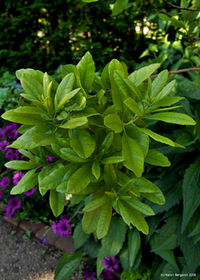Myrica cerifera
| See Also | Botanical Monographs |
|---|
Bayberry (Myrica cerifera) is used to treat sinus and chest congestion. To explore the characteristics, medicinal uses and prescribing considerations of this herb in more detail, check out the references indicated. [1], [2]
Contents
Characteristics
- Common Names: Bayberry, Candleberry bark, Myrica, Wax myrtle bark
- Family: Myrtaceae
- Habitat: Dry woods, or open fields, from Canada to southeastern U.S.A. (Florida)
- Parts Used: Root bark
- Constituents: Flavonoids (myricitrin), tannins, terpenoids (myricadiol, taraxerol, and taraxerone), gum, resin, starch, wax containing palmitic, myristic, and lauric acid esters
- Medicinal Actions: expectorant, astringent, sialagogue, stimulant, antimalarial, antimicrobial, antiparasitic, bitter, diaphoretic, hepatic, laxative, tonic
Uses
Historical Uses:
Early American colonist used the wax covering the plants berries to make candles. The leaves of this plant have a wonderful fragrance which is why it is often associated with the holiday season.
Medicinal Uses:
Internal
- Sinus and chest congestion, laryngitis
- Profuse mucous discharge with poor circulation (hypersecretion)
- Aphthous stomatitis with halitosis, ulcers, and foul stools
- Dysentery, mucoenteritis, measles, typhoid, scarlet fever, malaria, jaundice
- Stimulates digestion when taken before meals (2-10 drops)
- Stimulates blood production, nutrition in the very weak (slow pulse, low temperature, yellow tongue)
External
- Spongy, flabby, bleeding gums (apply powder)
- Sore throat of scarlatina (gargle)
- Muco-leucorrhea, excess bleeding (vaginal douche)
Prescribing Considerations
The information provided is intended to augment the treatment from a naturopathic doctor or other trained medical professional. Although most herbs are generally safe, it is recommended that you avoid self-prescribing especially when there is an underlying ongoing medical condition, if you are on any prescription medications or if you are pregnant or breastfeeding.
Formulations and Preparation
- Tincture - 15-20 drops every 3 hours, 1-60 drops in a single dose
- Fluid extract - 10 drops if dosing frequently, 40 drops twice a day up to 70-80 drops daily
Safety
The safety and prescribing considerations for Bayberry include:[3], [4]
- Generally regarded as safe.
- Side-effects are generally not seen. Large doses may cause typical mineralcorticoid side effects such as sodium and water retention and hypertension.
- Caution: use of Myrica cerifera during pregnancy and lactation should be avoided due to possible mineralcorticoid and carcinogenic activity.
- Drug-Herb Interactions are rare.[2]
References
- ↑ Boon Heather, Smith Michael (2009) 55 Most Common Medicinal Herbs: The Complete Natural Medicine Guide Second Edition, Institute of Naturopathic Education and Research, CCNM Toronto.
- ↑ 2.0 2.1 Godfrey Anthony, Saunders Paul, Barlow Kerry, Gowan Matt (2011) Principles and Practices of Naturopathic Botanical Medicine, Advanced Botanical Medicine. V3 CCNM Press, Toronto.
- ↑ Stargrove Mitchell Bebell, Treasure Jonathan, McKee Dwight L (2008) Herb, Nutrient and Drug Interactions: Clinical Implications and Therapeutic Strategies
- ↑ Brinker Francis (2010) Herbal Contraindications and Drug Interactions: Plus Herbal Adjuncts With Medicines, 4th Edition Eclectic Medical Publications.
